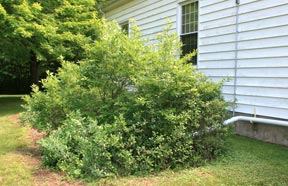Short-term
Although native plants have low fertilizer and water needs once established, they will need care in the short term. After planting, the plants should get an inch of water per week. If it does not rain, provide supplemental irrigation for 1-2 months, or longer if drought conditions exist.
- Inspect the area(s) where water enters and exits the garden for erosion. Make repairs as necessary, and add extra stones if needed to dissipate energy.
- Remove any weeds or invasive species that may start to grow in the garden.
Long-term
- Remove any dead branches from shrubs or trees, and dead vegetation from perennials and grasses. Depending on the look that you want from your garden, you can prune shrubs to keep them smaller, or let them grow larger. This will not impact the function of the garden.
- Remove weeds/invasives as needed.
- Add a thin layer of mulch annually, if desired. Alternatively, vegetated ground covers can be used. USE CAUTION WHEN ADDING MULCH! Do not add excessive amounts of mulch; this can fill up the storage area, or block the flow entrance to the garden.
- Inspect for erosion at the entrance/exit points, and/or sediment buildup in the top layer of the garden. If erosion occurred, remove the sediment and correct the problem.
Rain Garden Maintenance Video

Once the rain garden is established, plants should get an inch of water per week.

Once the rain garden is established, plants should get an inch of water per week.
For citation purposes: University of Connecticut’s Center for Land Use Education and Research. (December 30, 2021). Maintenance. https://nemo.uconn.edu/raingardens/maintenance